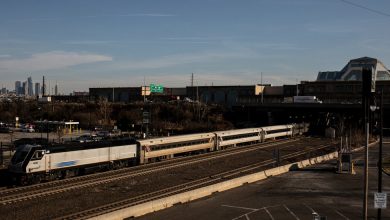Circling Sicily on Its Regional Trains

I was pacing impatiently in my hotel room on the Via Etnea, one of the main boulevards in the center of Catania. Looking out from my balcony, I wondered if the rain was ever going to stop. I’d arrived here on the eastern coast of Sicily earlier in the day, planning to complete a 2.5-week trip to document the Italian island’s culture of regional train travel, but the weather didn’t look promising.

A regional train cuts through the cityscape in Marsala, on Sicily’s western coast.
The idea for the project had come to me several months earlier when, on a holiday with my partner, I’d traveled by train on the slopes around Sicily’s famous — and famously active — volcano, Mount Etna.
As stunning as the views from the windows were, I was at least as intrigued by the seemingly outdated diesel train, quaint and romantic, that shuttled us past lava fields and olive groves. I decided to come back for a photo essay.
On Trenitalia’s website, I narrowed in on the three routes where commuters were dependent on the old-fashioned trains that I was interested in: the Ferrovia Circumetnea, a narrow-gauge train that connects the villages around Mount Etna; the Syracuse-Gela-Canicattì line, which traces Sicily’s southeastern coast; and a route near the western tip of Sicily that links the village of Piraineto and the city of Trapani, via the town of Castelvetrano.
I’d imagined a trip where I’d hop on and off the regional trains, visiting rural villages with beautiful Italian names and experiencing the charm of regional train travel at this southern edge of Europe. I also hoped to capture portraits of the people I encountered — daily commuters and train operators — who populated this corner of southern Italy, which is poorer and less developed than the country’s comparatively wealthier north.
Even for a Dutch person, I am an outstanding planner. Based on train timetables, I built an itinerary and booked hotels in places I didn’t know existed. But I soon learned that I would only experience the charm of infrequent and slow train travel if I was willing to let go of my overly fastidious schedule.
Looking down from my balcony in my flip-flops, I watched the street under me turn into a river. Cars got stuck; alarms went off; terrace tables and chairs floated away in the swirling floods.
Not wanting to lose another day to bad weather, I left my hotel the next morning, purchased the biggest umbrella I could find and hurried off to the railway station, operating under the wishful illusion that I could force my way through my itinerary. There I found out all trains on the first trajectory were canceled until further notice.
To salvage the second leg of my trip, and since the trains were still running, I traveled to Syracuse and decided to take a short trip to the city of Noto, some 20 miles to the southwest, on a colorful — and mostly empty — one-wagon train. Giuseppe Mandolfo, one of my few fellow passengers, told me that he takes the train five days a week to complete his studies at the police academy. “I can’t wait to buy my own car,” he said, since this particular train was “infrequent, slow and unreliable.”
Immediately after he told me this, the train screeched to a halt. We waited an hour for another train to arrive, hopped aboard and continued our journey.
Afraid I’d get stuck again, I returned to Syracuse and opted to wait for the incoming Medicane, or Mediterranean cyclone, to pass. Soon the entire city seemed to shut down. Making use of my rusty Italian, I found that buses had been scheduled as replacements on some of the routes on my list. I made my way back to the station and, soon enough, a big travel bus pulled up in front.
Stefano Giluno, the bus driver, was happy to see me, his lone passenger. He steered the bus with impressive agility through flooded streets and curved alleys to reach the town of Rosolini.
And so it went for much of the trip. Though I would never have expected to see so few trains on my regional train trip, I was nevertheless happy to proceed with my journey by bus, hopping on and off at the various stops, happy to glimpse so many old train stations along the regional outskirts of Sicily. The atmosphere of fading glory on the peeling buildings was reason enough to celebrate. I was also intrigued to find the stations being used as communal gathering spaces, particularly for young people looking to escape their crowded houses and unwind.
I knew from previous travels in Sicily that public transportation can be tricky to navigate on Sundays, so I planned a relaxing day in Ragusa, a hilltop city along the Syracuse-Gela-Canicattì line. On Monday, though, I was thwarted again: The train had been canceled because of a religious holiday. Laughing at my bad luck, I lingered for another day in Ragusa, a beautiful place, spending much of the day in a stunning cemetery on the northern edge of town.
Travel Trends That Will Define 2022
Looking ahead. As governments across the world loosen coronavirus restrictions, the travel industry hopes this will be the year that travel comes roaring back. Here is what to expect:
Air travel. Many more passengers are expected to fly compared to last year, but you’ll still need to check the latest entry requirements if you’re traveling abroad.
Lodging. During the pandemic, many travelers discovered the privacy offered by rental residences. Hotels hope to compete again by offering stylish extended-stay properties, sustainable options, rooftop bars and co-working spaces.
Rental cars. Travelers can expect higher prices, and older cars with high mileage, since companies still haven’t been able to expand their fleets. Seeking an alternative? Car-sharing platforms might be a more affordable option.
Cruises. Despite a bumpy start to the year, thanks to Omicron’s surge, demand for cruises remains high. Luxury expedition voyages are particularly appealing right now, because they typically sail on smaller ships and steer away from crowded destinations.
Destinations. Cities are officially back: Travelers are eager to dive into the sights, bites and sounds of a metropolis like Paris or New York. For a more relaxing time, some resorts in the U.S. are pioneering an almost all-inclusive model that takes the guesswork out of planning a vacation.
Experiences. Travel options centered around sexual wellness (think couples retreats and beachfront sessions with intimacy coaches) are growing popular. Trips with an educational bent, meanwhile, are increasingly sought after by families with children.
At last I was able to resume my journey — this time by train, according to a timetable. And for one day it was exactly as I’d imagined it to be: I slowly wound my way through breathtaking landscapes in an outmoded one-wagon train, the sun finally making its belated appearance.
Eventually I arrived in Gela, a coastal city whose train station was completely devoid of women. Local men gathered and gambled at the bar. Feeling slightly uncomfortable around them, I struck up a conversation with Giancarlo Zaccaria, a machinist with the train company. I watched as he walked to one end of the train to remove red filters from the lights, which he then carried to the opposite end, attaching them there. Something about his mannerisms reminded me of what I loved about my time around the regional trains — the shoestring mentality, the informality.
In western Sicily, blessed with pleasant weather, my trip took a more predictable turn. I divided the 100-miles route into three travel days: one each for Castelvetrano, Marsala and Trapani. Along the way I learned that in this often forgotten part of Sicily the train is largely used by African migrants. I learned how the conductors not only check passengers’ tickets but also have to manually control the traffic lights. And I learned that most Italians do not want to rely on the trains, since they are often slow and unreliable.
And yet, despite the exceptionally bad weather, the regional railroads — and the replacement bus services — managed to get me around the island of Sicily for less than $100. It’s a challenge that I would recommend to anyone who wants to surrender to the charm of slow travel. Just one bit of advice: Check the weather forecast before you go.
Sanne Derks is a Dutch freelance photojournalist and anthropologist. You can follow her work on Instagram.
Her project on Sicily’s regional trains was supported by a grant from Pictoright, an author’s rights organization for visual creators in the Netherlands.
Follow New York Times Travel on Instagram, Twitter and Facebook. And sign up for our weekly Travel Dispatch newsletter to receive expert tips on traveling smarter and inspiration for your next vacation. Dreaming up a future getaway or just armchair traveling? Check out our 52 Places list for 2022.





